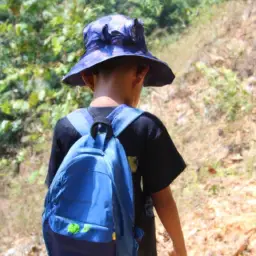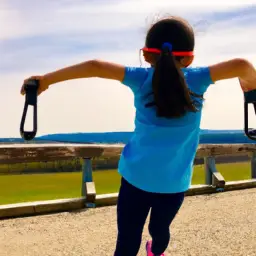If you’re a parent or a teacher, you’re probably aware of the importance of teaching grit and resilience to children. These two traits are crucial for success in life, but they’re not innate. They need to be developed and nurtured from a young age.
The good news is that there are different approaches to teaching grit and resilience, each with its own strengths and weaknesses. In this article, we’ll compare some of the most popular approaches and help you choose the best one for your child.
First, let’s take a look at the traditional approaches to teaching grit and resilience. These usually involve setting goals, emphasizing the importance of hard work, and praising effort over innate ability. While these approaches can be effective, they’re not always enough. Children need more than just a pep talk to develop grit and resilience.
That’s why there are newer approaches that incorporate mindfulness, play, and strengths-based approaches. So, let’s dive into these different methods and see how they stack up.
Key Takeaways
- Traditional approaches emphasize hard work, perseverance, and praising effort over innate ability.
- Mindfulness-based approaches can help manage emotions and develop self-awareness and emotional regulation.
- Praising effort over natural ability cultivates a growth mindset.
- Strengths-based approaches focus on building on a child’s strengths.
The Importance of Teaching Grit and Resilience to Children
Teaching kids grit and resilience is crucial for their long-term success, and it’s never too early to start. In fact, research has shown that the skills of perseverance and determination are necessary for achieving goals and overcoming obstacles in life.
The importance of grit and resilience in childhood development cannot be overstated, as children who possess these traits are better equipped to handle adversity and bounce back from setbacks.
Building a supportive environment for children’s emotional growth is key to fostering grit and resilience. This can be achieved by providing children with positive reinforcement, teaching them coping mechanisms for stress and anxiety, and modeling healthy behaviors and attitudes.
By instilling these values in children from a young age, we are setting them up for a lifetime of success and mental well-being. Remember, teaching kids grit and resilience is not just about preparing them for academic and career success, but for life’s challenges as well.
Traditional Approaches to Teaching Grit and Resilience
As you delve into traditional approaches to teaching grit and resilience, you’ll find that they often involve encouraging perseverance and hard work. They also involve praising effort instead of ability and providing opportunities for challenge and growth. These approaches emphasize the importance of putting in the effort and working through challenges rather than relying solely on innate abilities.
By adopting these strategies, you can help children develop a growth mindset. They can also build the resilience they need to overcome obstacles and achieve their goals.
Encouraging Perseverance and Hard Work
You can foster perseverance and hard work in children by consistently praising their efforts rather than just their achievements. This means acknowledging the hard work they put in, even if they don’t achieve the desired outcome.
Encourage them to set goals and work towards them, and praise them for their progress along the way. To further encourage perseverance and hard work, consider modeling the behavior you want to see in your children. Show them how you work hard towards your own goals, and how you don’t give up when faced with challenges.
Teach them that setbacks are just opportunities to learn and grow, and demonstrate resilience in the face of adversity. By setting a positive example and providing consistent encouragement, you can help your children develop grit and resilience that will serve them well throughout their lives.
Here are four tips to help you foster perseverance and hard work in children:
-
Avoid focusing solely on achievement and instead, encourage effort and progress.
-
Set goals with your child and help them work towards them at a pace that is challenging but achievable.
-
Model perseverance and resilience by sharing your own struggles and successes.
-
Reinforce the idea that failure is a natural part of the learning process and encourage children to try again when they encounter obstacles.
Praising Effort Instead of Ability
Praising effort over natural ability can cultivate a growth mindset in young minds, emphasizing the importance of hard work and perseverance.
When children are praised for their effort, regardless of the outcome, they learn that their hard work and determination matter more than their innate talents. This approach can help children develop a growth mindset, which focuses on the idea that intelligence and abilities can be developed through effort and practice.
Research suggests that praising effort can also lead to greater motivation and resilience in children. When children understand that their hard work is valued and can lead to success, they’re more likely to persevere in the face of challenges.
Praising effort can also help children develop a more positive attitude towards failure, as they learn to see it as an opportunity for growth and improvement.
Overall, praising effort over natural ability can help children develop a growth mindset, which can benefit them in many areas of their lives.
Providing Opportunities for Challenge and Growth
By offering challenging opportunities for growth, you are helping children to develop their grit and resilience. When children are given tasks that are just beyond their current abilities, they are forced to confront their limitations and push themselves to overcome them. This can be anything from a difficult math problem to a challenging physical activity. By providing these opportunities, you are fostering a growth mindset in children, encouraging them to embrace challenges as opportunities for learning and growth.
To help illustrate the importance of offering opportunities for challenge and growth, consider the following table:
| Fixed Mindset | Growth Mindset |
|---|---|
| Avoids challenges | Embraces challenges |
| Gives up easily | Persists through obstacles |
| Ignores feedback | Learns from feedback |
As you can see, a growth mindset is associated with a willingness to take on challenges, persist through obstacles, and learn from feedback. By providing opportunities for challenge and growth, you are helping children to develop this mindset and build their resilience. So next time you are working with children, think about how you can challenge them to stretch their abilities and reach new heights.
Mindfulness-Based Approaches
In this subtopic, you’ll explore mindfulness-based approaches to teaching grit and resilience. You’ll learn how teaching mindfulness and self-awareness can help children better understand and manage their emotions.
Additionally, you’ll discover how encouraging positive self-talk and building emotional intelligence can further enhance their ability to overcome challenges and bounce back from setbacks.
Teaching Mindfulness and Self-Awareness
Teaching children mindfulness and self-awareness is a powerful tool for helping them build resilience. Mindful breathing exercises and self-reflection activities can help children understand how their emotions affect them and how to manage their responses to difficult situations.
By helping children understand their own thoughts and feelings, mindfulness practices can give them greater control over their reactions and help them stay calm in the face of adversity. Through mindfulness practices, children learn to focus their attention on the present moment, rather than getting caught up in worries or concerns about the past or future.
This can help them develop greater self-awareness and emotional regulation, which are important skills for building resilience. By teaching children how to manage their emotions and stay centered in the present moment, we can help them develop the tools they need to navigate life’s challenges with greater confidence and resilience.
Encouraging Positive Self-Talk
Encouraging positive self-talk can make a big difference in how children perceive themselves and their abilities. By teaching them positive self-talk techniques, they can learn to replace negative thoughts with more positive and empowering ones.
Here are some tips on how to incorporate self-compassion when encouraging positive self-talk:
-
Acknowledge and validate their feelings: When a child is struggling with a difficult task or situation, it’s important to acknowledge their feelings and validate them. This helps them understand that their feelings are valid and that it’s okay to feel the way they do.
-
Use positive affirmations: Encourage your child to use positive affirmations to boost their confidence and self-esteem. This can be as simple as reminding themselves that they’re capable and strong.
-
Practice self-compassion: Teach your child to be kind to themselves and practice self-compassion. This means being gentle with themselves when they make mistakes and treating themselves with the same kindness they’d show to a friend.
-
Model positive self-talk: Children learn by example, so it’s important to model positive self-talk yourself. By showing your child how to speak kindly to themselves, you can help them develop a positive self-image and the resilience they need to face life’s challenges.
Building Emotional Intelligence
Now that you’ve learned about how positive self-talk can help children develop grit and resilience, let’s dive into another approach: building emotional intelligence.
Emotional intelligence refers to the ability to understand and manage one’s own emotions, as well as the emotions of others. Developing empathy and emotional regulation are key components of emotional intelligence, and can help children navigate difficult situations with more ease.
When children learn to empathize with others, they become better at recognizing and responding to the emotions of those around them. This can help them build stronger relationships and communicate more effectively.
On the other hand, emotional regulation refers to the ability to manage one’s own emotions in a healthy way. When children learn to regulate their emotions, they become better at coping with stress and handling challenging situations.
Developing empathy and emotional regulation are important skills that can help children build resilience and succeed in all areas of life.
Play-Based Approaches
Ready to explore a fun way to help your child develop grit and resilience? Play-based approaches might be the perfect solution for you!
There are many benefits of play, including improving cognitive development, enhancing creativity, and boosting social and emotional skills. By incorporating play into teaching grit and resilience, children can learn to persevere through challenges and setbacks while enjoying themselves at the same time.
One way to incorporate play into teaching grit and resilience is through games and activities that encourage problem-solving and perseverance. For example, a simple game of Jenga can teach children the importance of balance, strategy, and persistence. By taking turns pulling out blocks and trying not to topple the tower, children can practice overcoming challenges and adapting to unexpected outcomes.
Another fun activity is creating an obstacle course, where children have to work together to overcome various challenges and obstacles. By working as a team and trying different approaches, children can learn the value of collaboration, creativity, and resilience.
Strengths-Based Approaches
Utilizing a strengths-based approach can effectively cultivate a child’s character and foster a sense of self-efficacy. Strengths-based interventions focus on identifying and building on a child’s strengths rather than solely addressing weaknesses. This approach recognizes that every child has unique strengths and abilities that can be harnessed to promote resilience and grit.
Strengths-based assessment is a key component of this approach. It involves identifying a child’s strengths, interests, and passions, and using this information to create a plan that builds upon their existing strengths. This process not only helps to promote resilience and grit but also improves a child’s self-esteem and confidence. By focusing on their strengths, children can develop a sense of purpose and direction that can help them overcome challenges and build a strong foundation for their future.
| Strengths-based Interventions | Strengths-based Assessment | Benefits for Children |
|---|---|---|
| Emphasizes building on strengths rather than weaknesses | Identifies a child’s unique strengths and abilities | Improves self-esteem and confidence |
| Helps to promote resilience and grit | Uses this information to create a plan for building upon existing strengths | Develops a sense of purpose and direction |
| Improves self-esteem and confidence | Focuses on strengths rather than deficits | Fosters a sense of self-efficacy |
Overall, a strengths-based approach to teaching grit and resilience to children offers a positive and effective way to promote character development. By recognizing and building upon a child’s strengths, this approach can help children develop a strong sense of self-efficacy and purpose that will serve them well throughout their lives.
Choosing the Best Approach for Your Child
When it comes to choosing the best approach for teaching grit and resilience to your child, there are a few key points to consider.
Firstly, it’s important to understand your child’s unique needs and personality.
Secondly, you should consider your own teaching style and how it meshes with your child’s learning style.
Lastly, working with educators and professionals can provide valuable insights and support in developing a plan for teaching these important skills.
By taking these factors into account, you can choose an approach that is tailored to your child’s individual needs and will be most effective in helping them develop grit and resilience.
Understanding Your Child’s Needs
Understanding your child’s needs is crucial in developing their grit and resilience. Each child has unique strengths and challenges that require individualized support.
To identify your child’s triggers, pay attention to their behavior and reactions to different situations. For example, if your child gets easily frustrated when they struggle with a task, it might be helpful to teach them breathing exercises or positive self-talk to help them calm down and refocus.
Once you have identified your child’s triggers, you can develop individualized strategies to help them build their grit and resilience. For instance, if your child tends to give up easily when facing a challenge, you can encourage them to break the task down into smaller, more manageable steps.
Additionally, you can provide them with opportunities to practice their problem-solving skills and celebrate their successes along the way. By understanding your child’s needs and tailoring your approach to meet them, you can help them develop the skills they need to persevere through challenges and bounce back from setbacks.
Considering Your Own Teaching Style
Now that you’ve got a better understanding of your child’s needs, it’s time to think about your teaching style. Every parent has a unique way of communicating with their child, so it’s important to consider how your style may impact your child’s development of grit and resilience.
Are you a strict disciplinarian, or more laid back? Do you tend to solve problems for your child, or encourage them to find solutions on their own? These are all important factors to consider when teaching your child to be more resilient.
Assessing the effectiveness of your teaching approach is also crucial. Are your efforts helping your child develop grit and resilience, or are they falling short? It’s important to regularly evaluate your approach and make adjustments as needed.
Incorporating technology into your teaching can be a great way to engage your child and make learning more fun. There are many apps and games available that can help your child build resilience and develop grit. Consider adding a few to your child’s routine and see if they respond positively.
To summarize:
- Try incorporating technology into your teaching approach
- Evaluate the effectiveness of your current approach
- Consider adjusting your style to better suit your child’s needs
- Encourage your child to find solutions on their own
- Make learning more fun with games and apps.
Working with Educators and Professionals
Collaborating with educators and mental health professionals can make a significant impact on your child’s growth and development. Through partnerships with schools and organizations, you can gain access to a range of resources and strategies that can help build resilience and grit in your child.
One way to support this collaboration is by advocating for professional development for teachers. Encouraging schools to provide training on resilience-building techniques and evidence-based interventions can help educators better support their students and create a more positive and nurturing learning environment.
By working together with teachers and mental health professionals, you can ensure your child receives the best possible support for their emotional and academic development.
Frequently Asked Questions
What are some potential drawbacks or challenges of teaching grit and resilience to children?
Teaching grit and resilience to children can come with some potential drawbacks or challenges.
One of the challenges is getting parental involvement. Parents play a crucial role in reinforcing these skills at home, but not all parents may have the time, resources, or knowledge to do so. Therefore, it’s essential to find ways to engage parents and make them part of the teaching process.
Another challenge is teacher training. Not all teachers may have the necessary training or experience to effectively teach grit and resilience to children. It’s crucial to provide teachers with the necessary training and support to ensure that they can deliver the content effectively and help children develop these essential life skills.
How do cultural and socioeconomic factors impact the effectiveness of different approaches to teaching grit and resilience?
When considering how to effectively teach grit and resilience to children, it’s important to take into account cultural and socioeconomic factors that may impact the effectiveness of different approaches.
Cultural sensitivity is key to ensuring that all children feel valued and understood in the classroom. This means recognizing and understanding different cultural norms and beliefs, and tailoring instruction to meet the needs of diverse learners.
Additionally, individualized instruction is crucial for helping children build resilience and develop grit. Children from different backgrounds may have different experiences and challenges that require personalized support and guidance.
By taking these factors into account, educators can create a more inclusive and effective teaching environment for all children.
What are some potential long-term benefits of instilling grit and resilience in children?
Instilling grit and resilience in children can have numerous long-term benefits. First and foremost, having these qualities can prepare children for the inevitable challenges and setbacks they’ll face in adulthood. The ability to persevere through difficult situations and bounce back from failure is crucial for success in any field or pursuit.
Additionally, resilience has been linked to improved mental health outcomes, as individuals with this trait are better equipped to manage stress and cope with adversity. Developing grit and resilience in children can also lead to increased self-confidence and a sense of mastery over their own lives.
Ultimately, instilling these qualities in children is an investment in their future success and well-being.
How do different age groups and developmental stages affect the success of different teaching approaches?
When it comes to teaching grit and resilience to children, it’s important to consider the various developmental stages they may be in. Different age groups will respond differently to certain approaches, and what works for one child may not work for another.
As a teacher, it’s important to understand the unique needs of each child and tailor your teaching methods accordingly. Success in teaching grit and resilience will depend on your ability to adapt to each child’s developmental stage and provide them with the support and guidance they need to thrive.
Are there any ethical considerations to keep in mind when teaching grit and resilience to children?
When teaching grit and resilience to children, it’s important to consider ethical considerations and child development.
Firstly, ethical considerations must be kept in mind, as teaching these traits can be delicate and may involve challenging situations. For instance, pushing children to perform beyond their capabilities can be detrimental to their mental health and overall well-being.
Secondly, child development should be taken into account, as children of different ages have different learning capabilities and attention spans. Therefore, it’s crucial to tailor teaching approaches to specific age groups and developmental stages to ensure that children are able to understand and apply the concepts of grit and resilience effectively.
Conclusion
So, you’ve learned about the importance of teaching grit and resilience to children, and you’ve explored different approaches to achieve this goal. Each approach has its own advantages, so how do you choose the best one for your child?
Firstly, consider your child’s personality and learning style. Some children may respond well to mindfulness-based approaches, while others may benefit more from play-based or strengths-based approaches.
Secondly, assess your child’s needs and challenges. If your child is struggling with anxiety, a mindfulness-based approach may be helpful in teaching them to manage their emotions. If your child needs to develop their social skills, a play-based approach can provide opportunities for them to interact with others and practice communication.
Ultimately, the key is to find an approach that resonates with your child and is consistent with your values as a parent. By teaching your child grit and resilience, you’re equipping them with essential life skills that will help them navigate the challenges ahead.
So, don’t be afraid to try different approaches, and remember that the most important thing is to support and encourage your child as they grow and develop.









































































































